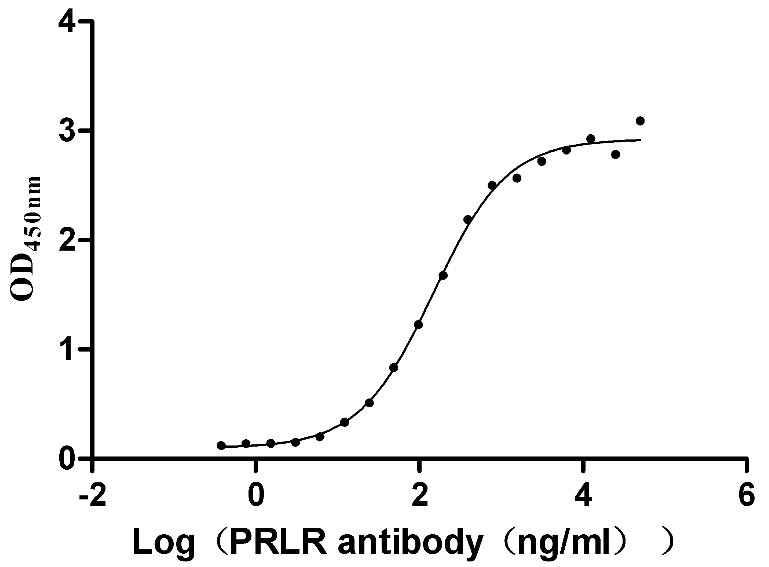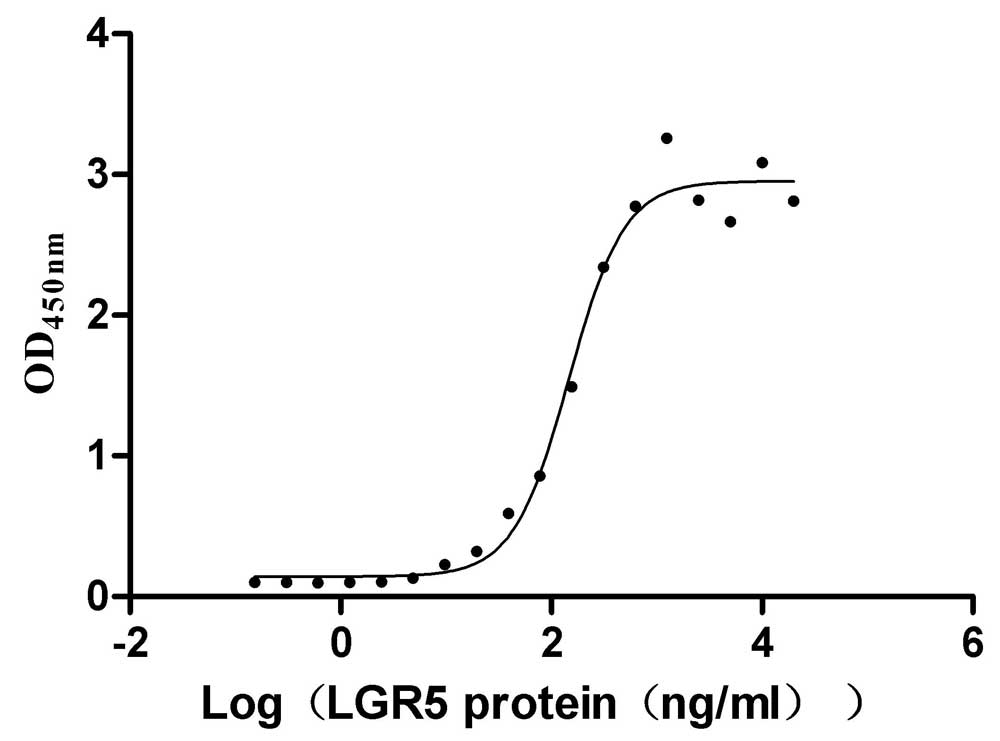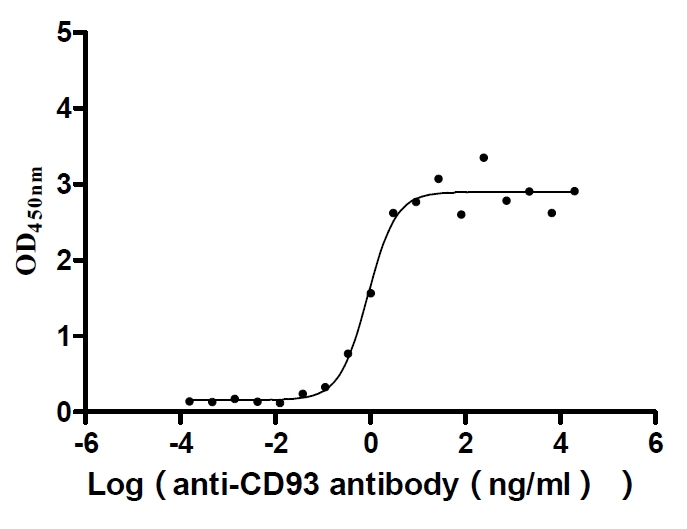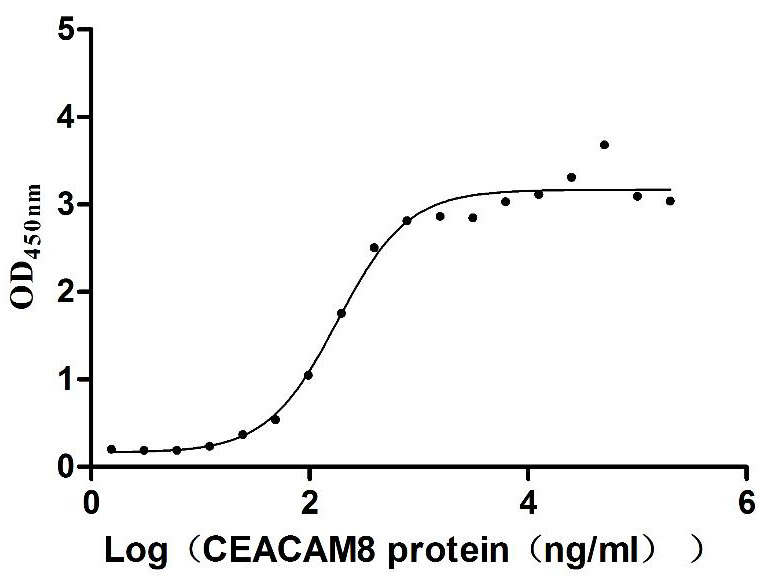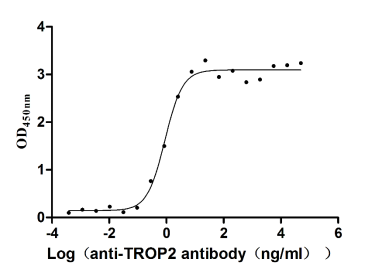Recombinant Mouse F-box/WD repeat-containing protein 11 (Fbxw11)
-
中文名稱:小鼠Fbxw11重組蛋白
-
貨號:CSB-YP722546MO
-
規(guī)格:
-
來源:Yeast
-
其他:
-
中文名稱:小鼠Fbxw11重組蛋白
-
貨號:CSB-EP722546MO
-
規(guī)格:
-
來源:E.coli
-
其他:
-
中文名稱:小鼠Fbxw11重組蛋白
-
貨號:CSB-EP722546MO-B
-
規(guī)格:
-
來源:E.coli
-
共軛:Avi-tag Biotinylated
E. coli biotin ligase (BirA) is highly specific in covalently attaching biotin to the 15 amino acid AviTag peptide. This recombinant protein was biotinylated in vivo by AviTag-BirA technology, which method is BriA catalyzes amide linkage between the biotin and the specific lysine of the AviTag.
-
其他:
-
中文名稱:小鼠Fbxw11重組蛋白
-
貨號:CSB-BP722546MO
-
規(guī)格:
-
來源:Baculovirus
-
其他:
-
中文名稱:小鼠Fbxw11重組蛋白
-
貨號:CSB-MP722546MO
-
規(guī)格:
-
來源:Mammalian cell
-
其他:
產(chǎn)品詳情
-
純度:>85% (SDS-PAGE)
-
基因名:
-
Uniprot No.:
-
別名:Fbxw11; Btrcp2; Fbw1b; Fbxw1bF-box/WD repeat-containing protein 11; F-box and WD repeats protein beta-TrCP2; F-box/WD repeat-containing protein 1B; Homologous to Slimb protein; HOS
-
種屬:Mus musculus (Mouse)
-
蛋白長度:full length protein
-
表達(dá)區(qū)域:1-542
-
氨基酸序列MEPDSVIEDK TIELMCSVPR SLWLGCANLV ESMCALSCLQ SMPSVRCLQI SNGTSSVIVS RKRPSEGNYQ KEKDLCIKYF DQWSESDQVE FVEHLISRMC HYQHGHINSY LKPMLQRDFI TALPEQGLDH IAENILSYLD ARSLCAAELV CKEWQRVISE GMLWKKLIER MVRTDPLWKG LSERRGWDQY LFKNRPTDGP PNSFYRSLYP KIIQDIETIE SNWRCGRHNL QRIQCRSENS KGVYCLQYDD DKIISGLRDN SIKIWDKSSL ECLKVLTGHT GSVLCLQYDE RVIVTGSSDS TVRVWDVNTG EVLNTLIHHN EAVLHLRFSN GLMVTCSKDR SIAVWDMASA TDITLRRVLV GHRAAVNVVD FDDKYIVSAS GDRTIKVWST STCEFVRTLN GHKRGIACLQ YRDRLVVSGS SDNTIRLWDI ECGACLRVLE GHEELVRCIR FDNKRIVSGA YDGKIKVWDL QAALDPRAPA STLCLRTLVE HSGRVFRLQF DEFQIISSSH DDTILIWDFL NVPPSAQNET RSPSRTYTYI SR
-
蛋白標(biāo)簽:Tag?type?will?be?determined?during?the?manufacturing?process.
The tag type will be determined during production process. If you have specified tag type, please tell us and we will develop the specified tag preferentially. -
產(chǎn)品提供形式:Lyophilized powder
Note: We will preferentially ship the format that we have in stock, however, if you have any special requirement for the format, please remark your requirement when placing the order, we will prepare according to your demand. -
復(fù)溶:We recommend that this vial be briefly centrifuged prior to opening to bring the contents to the bottom. Please reconstitute protein in deionized sterile water to a concentration of 0.1-1.0 mg/mL.We recommend to add 5-50% of glycerol (final concentration) and aliquot for long-term storage at -20℃/-80℃. Our default final concentration of glycerol is 50%. Customers could use it as reference.
-
儲存條件:Store at -20°C/-80°C upon receipt, aliquoting is necessary for mutiple use. Avoid repeated freeze-thaw cycles.
-
保質(zhì)期:The shelf life is related to many factors, storage state, buffer ingredients, storage temperature and the stability of the protein itself.
Generally, the shelf life of liquid form is 6 months at -20°C/-80°C. The shelf life of lyophilized form is 12 months at -20°C/-80°C. -
貨期:Delivery time may differ from different purchasing way or location, please kindly consult your local distributors for specific delivery time.Note: All of our proteins are default shipped with normal blue ice packs, if you request to ship with dry ice, please communicate with us in advance and extra fees will be charged.
-
注意事項:Repeated freezing and thawing is not recommended. Store working aliquots at 4°C for up to one week.
-
Datasheet :Please contact us to get it.
靶點(diǎn)詳情
-
功能:Substrate recognition component of a SCF (SKP1-CUL1-F-box protein) E3 ubiquitin-protein ligase complex which mediates the ubiquitination and subsequent proteasomal degradation of target proteins. Probably recognizes and binds to phosphorylated target proteins. SCF(FBXW11) mediates the ubiquitination of phosphorylated CTNNB1 and participates in Wnt signaling regulation. SCF(FBXW11) mediates the ubiquitination of phosphorylated NFKBIA, which degradation frees the associated NFKB1 to translocate into the nucleus and to activate transcription. SCF(FBXW11) mediates the ubiquitination of IFNAR1. SCF(FBXW11) mediates the ubiquitination of CEP68; this is required for centriole separation during mitosis. Involved in the oxidative stress-induced a ubiquitin-mediated decrease in RCAN1. Mediates the degradation of CDC25A induced by ionizing radiation in cells progressing through S phase and thus may function in the intra-S-phase checkpoint. Has an essential role in the control of the clock-dependent transcription via degradation of phosphorylated PER1 and phosphorylated PER2. SCF(FBXW11) mediates the ubiquitination of CYTH1, and probably CYTH2.
-
基因功能參考文獻(xiàn):
- The mTOR pathway promotes cell proliferation via beta-TrCP2-dependent p19(Arf) degradation under nutrient-rich conditions. PMID: 26240281
- Data show that beta-TrCP2 and beta-TrCP1 target PER2 protein in vitro, and also show that the beta-TrCP binding site of PER2 is recognized by both beta-TrCP1 and beta-TrCP2 [beta-TrCP2]. PMID: 18782782
-
亞細(xì)胞定位:Cytoplasm. Nucleus.
-
數(shù)據(jù)庫鏈接:
Most popular with customers
-
Recombinant Human Prolactin receptor (PRLR), partial (Active)
Express system: Mammalian cell
Species: Homo sapiens (Human)
-
Recombinant Human R-spondin-1 (RSPO1), partial (Active)
Express system: Mammalian cell
Species: Homo sapiens (Human)
-
Recombinant Human Epithelial discoidin domain-containing receptor 1 (DDR1), partial (Active)
Express system: Mammalian cell
Species: Homo sapiens (Human)
-
Recombinant Human Complement component C1q receptor (CD93), partial (Active)
Express system: Mammalian cell
Species: Homo sapiens (Human)
-
Recombinant Human Carcinoembryonic antigen-related cell adhesion molecule 6 (CEACAM6) (Active)
Express system: Mammalian cell
Species: Homo sapiens (Human)
-
Recombinant Human Tumor-associated calcium signal transducer 2 (TACSTD2), partial (Active)
Express system: Mammalian cell
Species: Homo sapiens (Human)
-
Recombinant Human C-type lectin domain family 4 member C (CLEC4C), partial (Active)
Express system: Mammalian cell
Species: Homo sapiens (Human)
-
Recombinant Human Carcinoembryonic antigen-related cell adhesion molecule 8(CEACAM8) (Active)
Express system: Mammalian cell
Species: Homo sapiens (Human)


